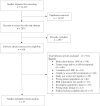Timing of Pubertal Milestones in Low- and Middle-Income Countries: A Systematic Review and Meta-Analysis
- PMID: 32027344
- PMCID: PMC7360440
- DOI: 10.1093/advances/nmaa007
Timing of Pubertal Milestones in Low- and Middle-Income Countries: A Systematic Review and Meta-Analysis
Abstract
Despite increasing global attention to adolescent health in low- and middle-income countries (LMICs), limited literature exists on the timing of pubertal development in these settings. This study aimed to determine the age at menarche (AAM) and age of puberty onset [female Tanner Stage Breast 2 (B2) and male Tanner Stage Genital 2 (G2)] among healthy adolescents living in LMICs. It also aimed to explore the impact of nutritional status on pubertal timing in this population. MEDLINE, Embase, Cochrane CENTRAL, Web of Science, Scopus, and grey literature databases were searched. Observational studies and control arms of randomized controlled trials (RCTs) with healthy participants from LMICs born in or after 1998 were included. Pooled estimates with 95% CIs were calculated by random-effects meta-analyses using the DerSimonian and Laird inverse variance method for each pubertal milestone and by BMI category subgroups. Twenty-seven studies were included in the meta-analysis, representing 90,188 adolescents (78.3% female). Pooled mean estimates for AAM for normal, thin, and overweight BMI groupings were 12.3 y (95% CI: 12.1, 12.5), 12.4 y (95% CI: 12.2, 12.6), and 12.1 y (95% CI: 11.7, 12.5), respectively. For Tanner Stage B2, pooled mean age estimates for normal, thin, and overweight BMI groupings were 10.4 y (95% CI: 9.2, 11.6), 10.2 y (95% CI: 9.3, 11.4), and 8.4 y (95% CI: 6.8, 10.0), respectively. Finally, for Tanner Stage G2, pooled mean estimates for normal, thin, and overweight BMI groupings were 11.0 y (95% CI: 10.3, 11.7), 11.3 y (95% CI: 9.8, 12.9), and 10.3 y (95% CI: 10.0, 10.6), respectively. Data on the timing of pubertal milestones has traditionally come from high-income settings. In this systematic review of contemporary data from adolescents in LMICs, AAM, as well as age at pubertal onset, were similar to those reported from high-income settings.
Keywords: BMI; low- and middle-income countries; meta-analysis; systematic review; timing of puberty.
Copyright © The Author(s) 2020.
Figures


References
-
- Rosen DS. Physiologic growth and development during adolescence. Pediatr Rev. 2004;25:194. - PubMed
-
- Wolf R, Long DN. Pubertal development. Pediatr Rev. 2016;37:292–300. - PubMed
-
- Biro FM. Normal puberty. Cambridge University Press, 2015;; 493–505.
-
- Herman-Giddens ME, Steffes J, Harris D, Slora E, Hussey M, Dowshen SA, Wasserman R, Serwint JR, Smitherman L, Reiter EO. Secondary sexual characteristics in boys: data from the Pediatric Research in Office Settings Network. Pediatrics. 2012;130:e1058–68. - PubMed
-
- Herman-Giddens ME, Slora EJ, Wasserman RC, Bourdony CJ, Bhapkar MV, Koch GG, Hasemeier CM. Secondary sexual characteristics and menses in young girls seen in office practice: a study from the Pediatric Research in Office Settings Network. Pediatrics. 1997;99:505–12. - PubMed

